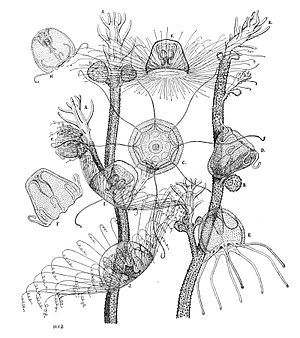Oceaniidae
| Oceaniidae | ||||||||||||
|---|---|---|---|---|---|---|---|---|---|---|---|---|

Turritopsis life cycle |
||||||||||||
| Systematics | ||||||||||||
|
||||||||||||
| Scientific name | ||||||||||||
| Oceaniidae | ||||||||||||
| Eschscholtz , 1829 |
The Oceaniidae are a marine family of the cnidarians (Cnidaria), which belongs to the class of the Hydrozoa (Hydrozoa). The family currently includes around 25 species. Turritopsis nutricula McCrady , 1859 is considered to be potentially immortal: cells of the exumbrella can, through differentiation, become the germ of a new polyp that can produce a colony again. This is genetically identical to the medusa.
features
The hydroid polyps are monomorphic or also polymorphic. They are sessile, stolonal, or branched colonies. The feeding polyps ( gastrozooids ) have filiform tentacles, which are distributed over the distal third of the hydrant body ; they are not concentrated in rows or wreaths. The gonophores are either free medusas or fixed spore sacs. They develop either below the body of the hydrant or directly on stolons. These can be differentiated into stalked blastostyles. The stems are covered with perisarc. The free medusa, when medusa are formed, has a mouth with four lips. The edges of the lips are fringed and covered with numerous rounded tufts of nettle cells. There are four simply radial channels. The juvenile medusas have four or more tentacles, the adult medusas many tentacles (130 and more), but these are not grouped together. The nettle cells are evenly distributed over the entire tentacles. The gonads sit on the interradial areas of the outer wall of the manubrium . Ocelli are available; they sit at the base of the tentacles.
Geographical occurrence
The representatives of the family are common in the seas around the world. They also penetrate into brackish areas or almost freshwater areas (1–15 ‰).
Systematics
The family monophyly has not yet been proven. Individual genera are or were previously combined with the genus Clava in a family Clavidae. However, the type genus of the Clavidae is now part of the Hydractiniidae family . According to the World Hydrozoa Database , the family currently comprises nine genera:
-
Cordylophora Allman , 1843, below
- Club polyp , ( Cordylophora caspia Pallas , 1771)
- Corydendrium van Beneden , 1844
- Corystolona Watson , 2002
- Merona Norman , 1865
- Oceania Péron & Lesueur , 1810
- Rhizogeton Agassiz , 1862
- Similomerona Schuchert , 2004
-
Turritopsis McCrady , 1857, below
- Turritopsis dohrnii Weismann , 1883
- Turritopsis nutricula McCrady , 1859
- Turritopsoides Calder , 1988
swell
literature
- Jean Bouillon & Ferdinando Boero: Synopsis of the families and genera of the hydromedusae of the world, with a list of worldwide species. Thalassia Salentina, 24, 2000, pp. 47-296. ISSN 0563-3745 PDF
- Peter Schuchert: Revision of the European athecate hydroids and their medusae (Hydrozoa, Cnidaria): Families Oceaniidae and Pachycordylidae. Rev. Suisse Zool., Vol. 111 (2), 2004, pp. 315-369. PDF
- Marymegan Daly, Mercer R. Brugler, Paulyn Cartwright, Allen G. Collin, Michael N. Dawson, Daphne G. Fautin, Scott C. France, Catherine S. McFadden, Dennis M. Opresko, Estefania Rodriguez, Sandra L. Romano & Joel L. Stake: The phylum Cnidaria: A review of phylogenetic patterns and diversity 300 years after Linnaeus. Zootaxa, 1668: pp. 127-182, Wellington 2007 ISSN 1175-5326 Abstract - PDF